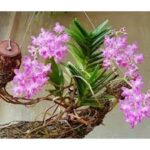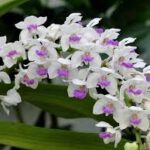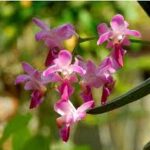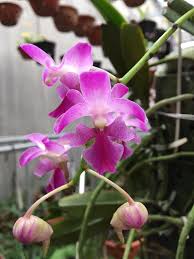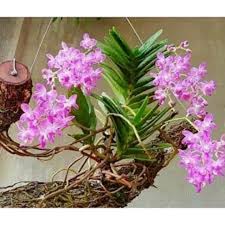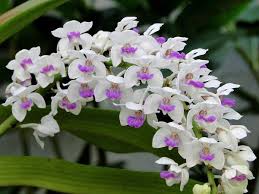
Sato Cymbidium orchids, renowned for their stunning blooms and lush foliage, are a prized addition to any garden. To ensure these exquisite flowers thrive, creating an ideal living area that meets their specific needs is crucial. This article will guide you through the essential components for establishing a suitable environment for Sato Cymbidium orchids, focusing on light, temperature, humidity, soil, and protection from pests and diseases.
#### Understanding the Natural Habitat of Sato Cymbidium Orchids
Before diving into the specifics of creating an ideal living area, it is essential to understand the natural habitat of Sato Cymbidium orchids. These orchids are native to Southeast Asia, where they grow in warm, humid climates. They typically thrive in shaded environments, often found in the understory of forests, where they receive filtered light and protection from harsh weather conditions.
By mimicking these natural conditions, gardeners can provide Sato Cymbidium orchids with a comfortable and nurturing environment that promotes healthy growth and vibrant blooms.
#### 1. Selecting the Right Location
Choosing the right location for your Sato Cymbidium orchids is one of the most critical steps in creating an ideal living area. Consider the following factors when selecting a site in your garden:
– **Light Exposure:** Sato Cymbidium orchids prefer bright, indirect light. Too much direct sunlight can scorch their leaves, while insufficient light may hinder their growth and flowering. Look for a location that receives filtered sunlight, such as an area with dappled shade from taller plants or trees.
– **Protection from Elements:** Consider placing your orchids in a sheltered area to protect them from strong winds and heavy rains. Planting them near a wall or fence can provide some windbreak, while overhanging branches can shield them from excessive rainfall.
– **Accessibility for Care:** Choose a location that allows for easy access to the plants for regular maintenance, including watering, fertilizing, and pruning. This will help ensure that you can easily monitor their growth and health.
#### 2. Preparing the Soil
The right soil mix is vital for the health of Sato Cymbidium orchids. Unlike many garden plants, orchids prefer well-draining soil that allows air circulation around their roots. Here are some tips for preparing the ideal soil:
– **Choosing the Right Mix:** A commercial orchid potting mix is often the best choice for Sato Cymbidium orchids. Look for a blend that contains materials like pine bark, perlite, and sphagnum moss, which provide excellent drainage and aeration.
– **Creating a Custom Mix:** If you prefer to create your mix, consider combining equal parts of coarse orchid bark, perlite, and sphagnum moss. This combination allows for proper drainage while retaining some moisture, crucial for the orchids’ health.
– **Testing Soil pH:** Sato Cymbidium orchids thrive in slightly acidic to neutral soil, with a pH range of 5.5 to 7.0. Testing your soil’s pH can help you adjust its composition if needed. If the soil is too alkaline, consider adding some organic matter or amendments like peat moss to lower the pH.
#### 3. Ensuring Proper Drainage
Proper drainage is essential for Sato Cymbidium orchids, as waterlogged conditions can lead to root rot and other issues. Here are some strategies to ensure adequate drainage in your garden setup:
– **Using Raised Beds or Containers:** Planting orchids in raised beds or containers can help improve drainage. These options allow excess water to escape while keeping the roots dry and healthy. If using containers, ensure they have drainage holes at the bottom.
– **Incorporating Drainage Materials:** When planting in the ground, consider incorporating materials like gravel or coarse sand into the soil to improve drainage. This will help prevent water from pooling around the roots.
– **Monitoring Watering Practices:** Regularly check the moisture level of the soil before watering. Allow the top inch of soil to dry out between waterings to prevent overwatering.
#### 4. Controlling Temperature
Temperature plays a crucial role in the growth of Sato Cymbidium orchids. These orchids prefer a range of temperatures to thrive, and maintaining appropriate conditions is key. Here are some tips for controlling temperature:
– **Understanding Temperature Requirements:** Sato Cymbidium orchids prefer daytime temperatures between 70°F and 80°F (21°C to 27°C) and nighttime temperatures between 50°F and 60°F (10°C to 15°C).
– **Using Shade Cloth:** During particularly hot weather, consider using shade cloth to protect your orchids from excessive heat. This material can help lower the temperature around the plants while still allowing some light to filter through.
– **Creating Microclimates:** Planting Sato Cymbidium orchids near larger plants or structures can help create a microclimate that offers some temperature regulation. Taller plants can provide shade during the hottest parts of the day, while walls can retain heat during cooler nights.
#### 5. Providing Adequate Humidity
As discussed in the previous part, humidity is essential for the health of Sato Cymbidium orchids. Maintaining the right humidity levels in your garden can enhance the growth and flowering of these beautiful plants. Here’s how to create a humid environment:
– **Misting Plants:** Misting your orchids regularly can help maintain humidity levels, especially during dry spells. However, be sure to mist in the morning to allow the foliage to dry before nighttime, preventing fungal issues.
– **Using Water Trays:** Place shallow trays filled with water and pebbles beneath your orchids. As the water evaporates, it will increase the humidity around the plants without saturating the soil.
– **Incorporating Companion Plants:** Grouping Sato Cymbidium orchids with other humidity-loving plants can help create a more humid microenvironment. Ferns and tropical plants are excellent companions that can thrive alongside orchids.
#### 6. Managing Sunlight Exposure
While Sato Cymbidium orchids appreciate bright light, it’s important to manage their exposure to sunlight to prevent leaf burn. Here are some tips for providing the right amount of light:
– **Observing Sunlight Patterns:** Take note of how sunlight moves across your garden throughout the day. This will help you identify the best location for your orchids, where they will receive adequate light without direct exposure to the harsh afternoon sun.
– **Using Plant Covers:** If your orchids are exposed to direct sunlight for extended periods, consider using plant covers or shade cloth to filter the light. This can help protect the leaves from scorching while still providing the necessary light for growth.
– **Rotating Pots:** If your Sato Cymbidium orchids are planted in pots, regularly rotate them to ensure even light exposure on all sides. This will encourage balanced growth and prevent the plants from leaning toward the light source.
#### 7. Protecting from Pests and Diseases
Sato Cymbidium orchids can be susceptible to various pests and diseases if not properly cared for. Creating a healthy living area can help minimize these risks. Here are some preventive measures:
– **Regular Inspections:** Frequently check your orchids for any signs of pests, such as aphids, spider mites, or scale insects. Early detection is crucial for effective treatment.
– **Promoting Air Circulation:** Good air circulation is essential for preventing fungal diseases. Space your orchids adequately to allow airflow and avoid overcrowding.
– **Using Organic Pesticides:** If pests are detected, consider using organic pesticides or insecticidal soaps to manage infestations. Always follow the manufacturer’s instructions and apply treatments during cooler parts of the day to minimize stress on the plants.
#### 8. Seasonal Considerations
Seasonal changes can impact the living conditions for Sato Cymbidium orchids in your garden. Being aware of these changes can help you adapt your care practices accordingly.
– **Spring Growth:** As temperatures rise in spring, Sato Cymbidium orchids will begin their active growth phase. This is an excellent time to fertilize and ensure adequate humidity levels to promote healthy growth.
– **Summer Heat:** During the hot summer months, monitor your orchids closely for signs of heat stress. Adjust your watering and shading practices to prevent overheating.
– **Fall Dormancy:** As temperatures begin to drop in the fall, Sato Cymbidium orchids may enter a period of dormancy. Reduce watering and fertilization during this time, and protect the plants from any potential frost.
– **Winter Care:** In winter, humidity levels can drop significantly due to indoor heating. Use humidifiers or water trays to maintain a suitable environment, and monitor the temperature closely to ensure the orchids do not get too cold.
#### Conclusion
Creating an ideal living area for Sato Cymbidium orchids in your garden involves careful consideration of light, temperature, humidity, soil, and protection from pests and diseases. By understanding the specific needs of these orchids and implementing the strategies outlined in this article, you can provide an optimal environment that promotes healthy growth and stunning blooms.
In the second part of this article, we will explore additional tips and techniques for enhancing the care of your Sato Cymbidium orchids, including advanced fertilization methods, seasonal adjustments, and long-term maintenance strategies. With the right care, your Sato Cymbidium orchids will flourish, adding beauty and elegance to your garden for years to come.
### Creating an Ideal Living Area for Sato Cymbidium Orchids in the Garden (Part 2)
In the first part of this article, we explored the essential components for creating an ideal living area for Sato Cymbidium orchids in your garden, including light, temperature, humidity, soil, and pest protection. In this second part, we will delve into advanced techniques for enhancing the care of these beautiful orchids, covering topics such as fertilization methods, seasonal adjustments, long-term maintenance strategies, and more. By implementing these practices, you can ensure your Sato Cymbidium orchids thrive, showcasing their stunning blooms and lush foliage.
#### 1. Advanced Fertilization Techniques
Proper fertilization is crucial for promoting the health and vigor of Sato Cymbidium orchids. While basic fertilization is important, implementing advanced techniques can further enhance their growth and flowering potential.
– **Choosing the Right Fertilizer:** Select a balanced fertilizer specifically formulated for orchids. A typical NPK (nitrogen, phosphorus, potassium) ratio of 30-10-10 is ideal for promoting leaf growth, while a 10-30-20 ratio can encourage blooming. Look for slow-release granules or liquid fertilizers designed for orchids.
– **Dilution and Frequency:** Always dilute liquid fertilizers to half the recommended strength to avoid over-fertilization, which can harm the roots. Fertilize every 2-4 weeks during the active growth period (spring and summer) and reduce frequency during dormancy (fall and winter).
– **Foliar Feeding:** In addition to soil fertilization, consider foliar feeding as an effective method to deliver nutrients directly to the leaves. Use a diluted liquid fertilizer and spray it onto the foliage, especially during the growing season. This method can boost nutrient absorption and promote healthy leaf growth.
#### 2. Seasonal Adjustments in Care
Understanding the seasonal changes in your garden can help you make necessary adjustments to your care practices for Sato Cymbidium orchids. Each season presents unique challenges and opportunities for enhancing their growth.
– **Spring Care:** As temperatures rise and daylight hours increase in spring, Sato Cymbidium orchids enter their active growth phase. This is the perfect time to increase watering and fertilization to support new growth. Monitor humidity levels and provide additional misting if necessary. Regularly check for pests, as warmer weather can attract them.
– **Summer Maintenance:** During the hot summer months, be vigilant about maintaining adequate humidity and protecting your orchids from direct sunlight. Increase watering frequency to prevent drying out, but ensure proper drainage to avoid root rot. Consider using shade cloth to shield the orchids during peak sunlight hours.
– **Fall Preparation:** As the weather cools in the fall, begin to taper off watering and fertilization. Reduce humidity levels slightly, as orchids may enter a dormant phase. Protect your orchids from potential frost, especially in areas with colder climates.
– **Winter Care:** In winter, Sato Cymbidium orchids require special attention. Ensure they are kept in a warmer location, ideally between 50°F and 60°F (10°C to 15°C). Water less frequently, allowing the top inch of soil to dry out between waterings. Monitor humidity levels, as indoor heating can cause dryness. Consider using humidifiers or placing water trays with pebbles near the orchids to maintain humidity.
#### 3. Long-term Maintenance Strategies
Long-term maintenance of Sato Cymbidium orchids involves consistent care practices that promote healthy growth and blooming over the years. Here are some strategies to consider:
– **Repotting:** Sato Cymbidium orchids benefit from repotting every 1-2 years. This process allows you to refresh the potting mix and assess the health of the roots. Choose a pot slightly larger than the current one, and use fresh orchid potting mix to encourage healthy root growth.
– **Dividing Orchids:** If your Sato Cymbidium orchids become overcrowded in their pots, it may be time to divide them. This is typically done during repotting. Gently separate the clumps of bulbs, ensuring each division has at least 3-4 pseudobulbs and healthy roots. Repot the divisions in new potting mix to promote growth.
– **Monitoring for Signs of Stress:** Regularly observe your orchids for any signs of stress, such as yellowing leaves, stunted growth, or reduced flowering. These indicators may suggest issues with watering, light exposure, or nutrient deficiencies. Address these problems promptly to restore the health of your plants.
#### 4. Environmental Enhancements
Creating an ideal living area for Sato Cymbidium orchids goes beyond basic care. Implementing environmental enhancements can contribute significantly to their overall health and flowering potential.
– **Humidity Domes:** For those growing orchids in less humid environments, consider using humidity domes or terrariums to maintain optimal moisture levels. These structures can help retain humidity while providing protection from pests.
– **Grouping Plants:** Grouping Sato Cymbidium orchids with other humidity-loving plants can create a microclimate that enhances humidity levels. Ferns, peace lilies, and other tropical plants can thrive alongside orchids, benefiting both plant groups.
– **Installing Grow Lights:** If natural light is limited in your garden or home, consider installing grow lights to supplement light exposure. LED grow lights are energy-efficient and can provide the necessary spectrum of light for healthy growth. Position the lights 12-18 inches above the plants and adjust the duration of light exposure according to the season.
#### 5. Pest and Disease Management
Preventing pests and diseases is essential for maintaining the health of Sato Cymbidium orchids. Implementing integrated pest management strategies can help you minimize risks.
– **Encouraging Beneficial Insects:** Introduce beneficial insects, such as ladybugs and lacewings, to your garden to help control pest populations. These insects can naturally reduce the prevalence of aphids, spider mites, and other harmful pests.
– **Proper Hygiene Practices:** Maintain cleanliness in your garden area by regularly removing fallen leaves and debris that can harbor pests and diseases. Clean your tools and pots before use to prevent transferring pathogens to your orchids.
– **Organic Treatments:** If pest issues arise, consider using organic treatments like neem oil or insecticidal soap. These options are less harmful to beneficial insects and the environment. Always follow the manufacturer’s instructions for application.
#### 6. Creating a Companion Planting Strategy
Companion planting can enhance the growth and health of your Sato Cymbidium orchids. By strategically placing compatible plants nearby, you can create a more dynamic and thriving garden environment.
– **Selecting Companion Plants:** Choose companion plants that thrive in similar light and humidity conditions. Suitable options include ferns, bromeliads, and other orchids. These plants can provide additional humidity and shade, benefiting the Sato Cymbidium orchids.
– **Utilizing Ground Covers:** Ground covers, such as moss or low-growing ferns, can help retain moisture in the soil and create a natural aesthetic around your orchids. These plants can also prevent soil erosion and suppress weed growth.
– **Spacing Considerations:** Ensure that companion plants do not overcrowd your orchids. Adequate spacing allows for proper air circulation and light exposure, minimizing the risk of fungal diseases.
#### 7. Embracing Experimentation and Observation
Creating an ideal living area for Sato Cymbidium orchids is an ongoing journey that requires observation and experimentation. Every garden is unique, and what works for one may not work for another. Embrace the following practices:
– **Documenting Growth Patterns:** Keep a gardening journal to document the growth patterns, blooming cycles, and care practices for your Sato Cymbidium orchids. This record can help you identify successful strategies and make adjustments when necessary.
– **Experimenting with New Techniques:** Don’t hesitate to try new care techniques or growing methods. Experimentation can lead to valuable insights about the specific needs of your orchids and help you optimize their growing conditions.
– **Joining Gardening Communities:** Engage with fellow orchid enthusiasts through online forums or local gardening clubs. Sharing experiences and learning from others can provide valuable knowledge and inspiration for your own gardening journey.
#### 8. Educational Resources and Continuing Care
To further enhance your understanding of Sato Cymbidium orchids and their care, consider accessing educational resources.
– **Books and Online Courses:** Numerous books and online courses focus on orchid care, providing in-depth information about specific species, fertilization techniques, and pest management strategies.
– **Orchid Shows and Exhibits:** Attending orchid shows and exhibits can expose you to various species and hybrids, inspiring new ideas for your own garden. You can also connect with experienced growers who can share their expertise.
– **Workshops and Seminars:** Many gardening centers and botanical gardens offer workshops and seminars on orchid care. Participating in these events can provide hands-on experience and valuable insights into best practices.
#### Conclusion
Creating an ideal living area for Sato Cymbidium orchids involves a multifaceted approach that includes proper light, temperature, humidity, soil, and pest management. By implementing advanced care techniques, adjusting seasonal practices, and fostering an environment that promotes growth, you can enjoy the beauty and elegance of these stunning orchids in your garden.
With ongoing observation, experimentation, and education, your Sato Cymbidium orchids will not only thrive but will also bring joy and vibrancy to your outdoor space for many years to come. As you continue to nurture these exquisite flowers, remember that the journey of gardening is as rewarding as the blooms themselves.

